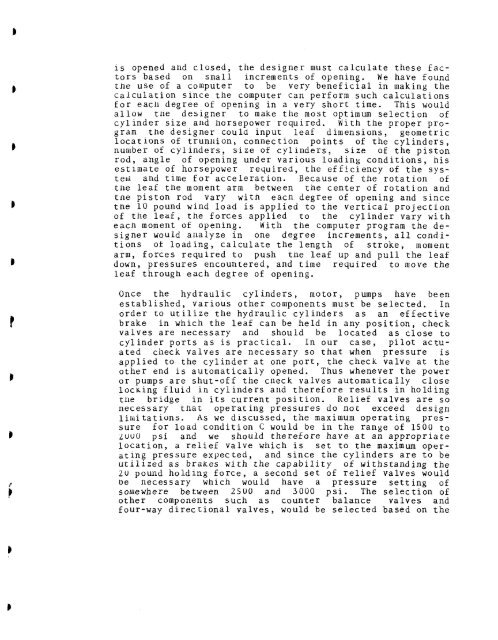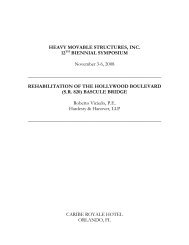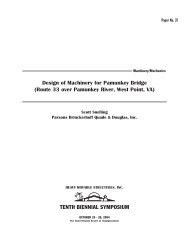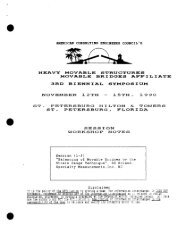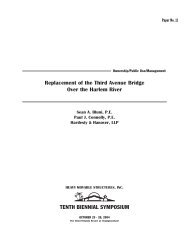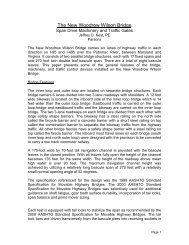AASHTO Design Criteria Applied to Hydraulic Bascule Bridges
AASHTO Design Criteria Applied to Hydraulic Bascule Bridges
AASHTO Design Criteria Applied to Hydraulic Bascule Bridges
You also want an ePaper? Increase the reach of your titles
YUMPU automatically turns print PDFs into web optimized ePapers that Google loves.
is opened and closed, the designer must calculate these fac<strong>to</strong>rsbased on small increments of opening. We have foundthe use of a computer <strong>to</strong> be very beneficial in making thecalculation since the computer can perform such calculationsfor eacli degree of opening in a very short time. This wouldallow tne designer <strong>to</strong> make the most optimum selection ofcylinder size arid horsepower required. With the proper programthe designer could input leaf dimensions, geometriclocat ions of trunriion, connection points of the cylinders,number of cylinders, size of cylinders, size of the pis<strong>to</strong>nrod, angle of opening under various loading conditions, hisestimate of horsepower required, the efficiency of the systell1and time for acceleration. Because of the rotation ofthe leaf the moment arm between the center of rotation andtne pis<strong>to</strong>n rod vary with each degree of opening and sincethe 10 pound wind load is applied <strong>to</strong> the vertical projectionof the leaf, the forces applied <strong>to</strong> the cylinder vary witheach moment of opening. With the computer program the designerwould analyze in one degree increments, all conditionsof loading, calculate the length of stroke, momentarm, forces required <strong>to</strong> push tne leaf up and pull the leafdown, pressures encountered, and time required <strong>to</strong> move theleaf through each degree of opening.Once the hydraulic cylinders, mo<strong>to</strong>r, pumps have beenestablished, various other components must be selected. Inorder <strong>to</strong> utilize the hydraulic cylinders as an effectivebrake in which the leaf can be held in any position, checkvalves are necessary and should be located as close <strong>to</strong>cylinder ports as is practical. In our case, pilot actuatedcheck valves are necessary so that when pressure isapplied <strong>to</strong> the cylinder at one port, the check valve at theother end is au<strong>to</strong>matically opened. Thus whenever the poweror pumps are shut-off the crleck valves au<strong>to</strong>matically closelocking fluid in cylinders and therefore results in holdingtile bridge in its current position. Relief valves are sonecessary that operating pressures do not exceed designliioitations. As we discussed, the maximum operating pressurefor load condition C would be in the range of 1500 <strong>to</strong>LUUU psi and we should therefore have at an appropriatelocation, a relief valve which is set <strong>to</strong> the maximum operatingpressure expected, and since the cylinders are <strong>to</strong> beutilized as brakes with the capability of withstanding theZu pound holding force, a second set of relief valves wouldbe necessary which would have a pressure setting ofsomewhere between 25UO and 3000 psi. The selection ofother components such as counter balance valves andfour-way directional valves, would be selected based on the


